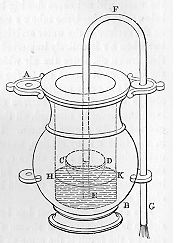LET there be a vessel, A B, (fig. 3.) containing water, on which a small basin, C D, floats, having its mouth covered with the lid C D.
 Throngh F this lid and the bottom of the basin insert one leg of the
siphon soldering it into the holes with
tin. Let the other leg be outside the vessel A B, having its
mouth lower than the surface of the water in A B. If we draw
the air in the siphon through the outer extremity, the water
will at once follow because of the
impossibility of a continuous vacuum in the siphon;
and the siphon, having begun to flow, flows on until it has exhausted
all the water in the vessel: but the discharge will be uniform, since
the projection of the outer leg below the surface of the water does not
vary; for, as the vessel be comes empty, the basin sinks with the siphon.
The greater the excess of the outer leg the greater will be the
velocity of the discharge, yet still uniform. In the figure, E F G is
the siphon described, and the surface of the water is in the line H K.
Throngh F this lid and the bottom of the basin insert one leg of the
siphon soldering it into the holes with
tin. Let the other leg be outside the vessel A B, having its
mouth lower than the surface of the water in A B. If we draw
the air in the siphon through the outer extremity, the water
will at once follow because of the
impossibility of a continuous vacuum in the siphon;
and the siphon, having begun to flow, flows on until it has exhausted
all the water in the vessel: but the discharge will be uniform, since
the projection of the outer leg below the surface of the water does not
vary; for, as the vessel be comes empty, the basin sinks with the siphon.
The greater the excess of the outer leg the greater will be the
velocity of the discharge, yet still uniform. In the figure, E F G is
the siphon described, and the surface of the water is in the line H K.